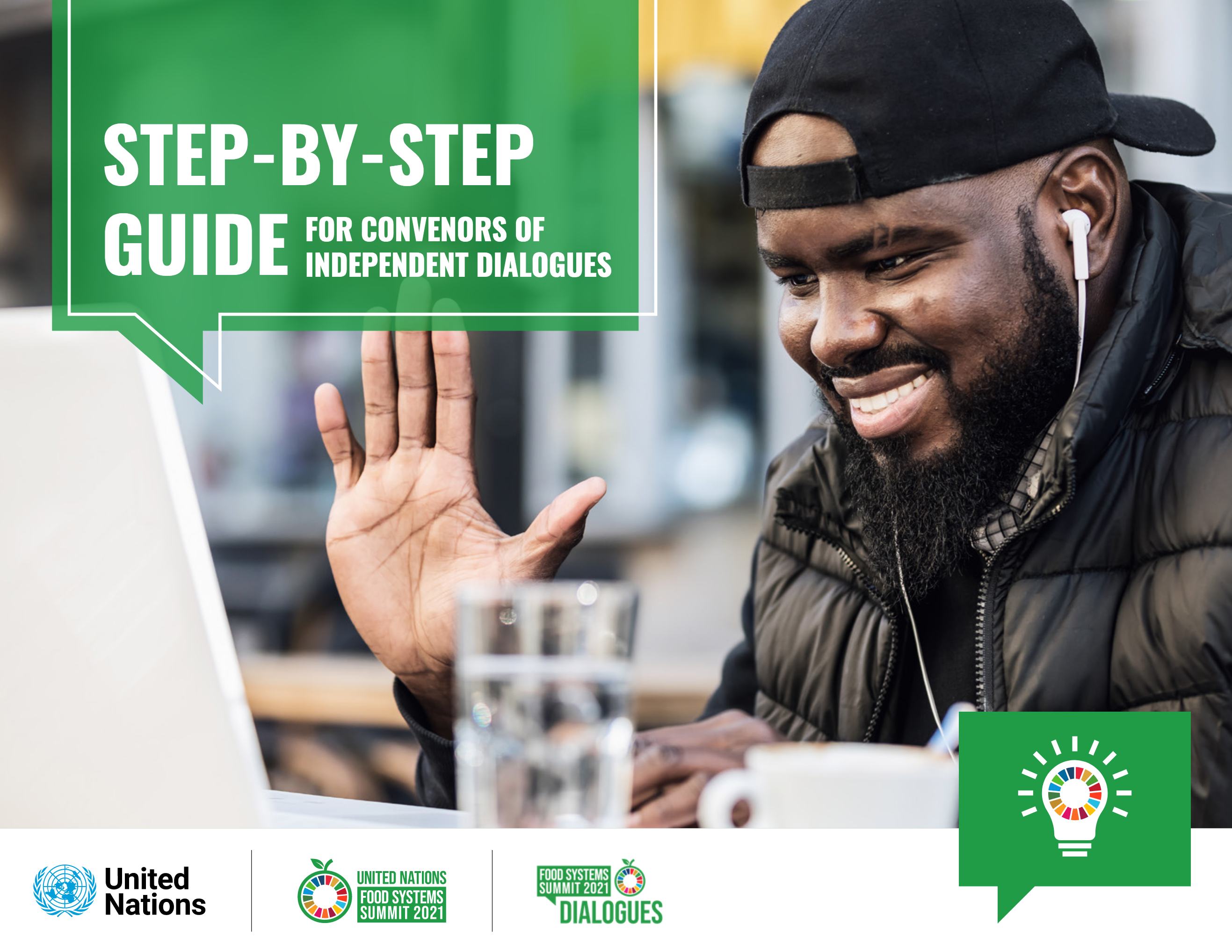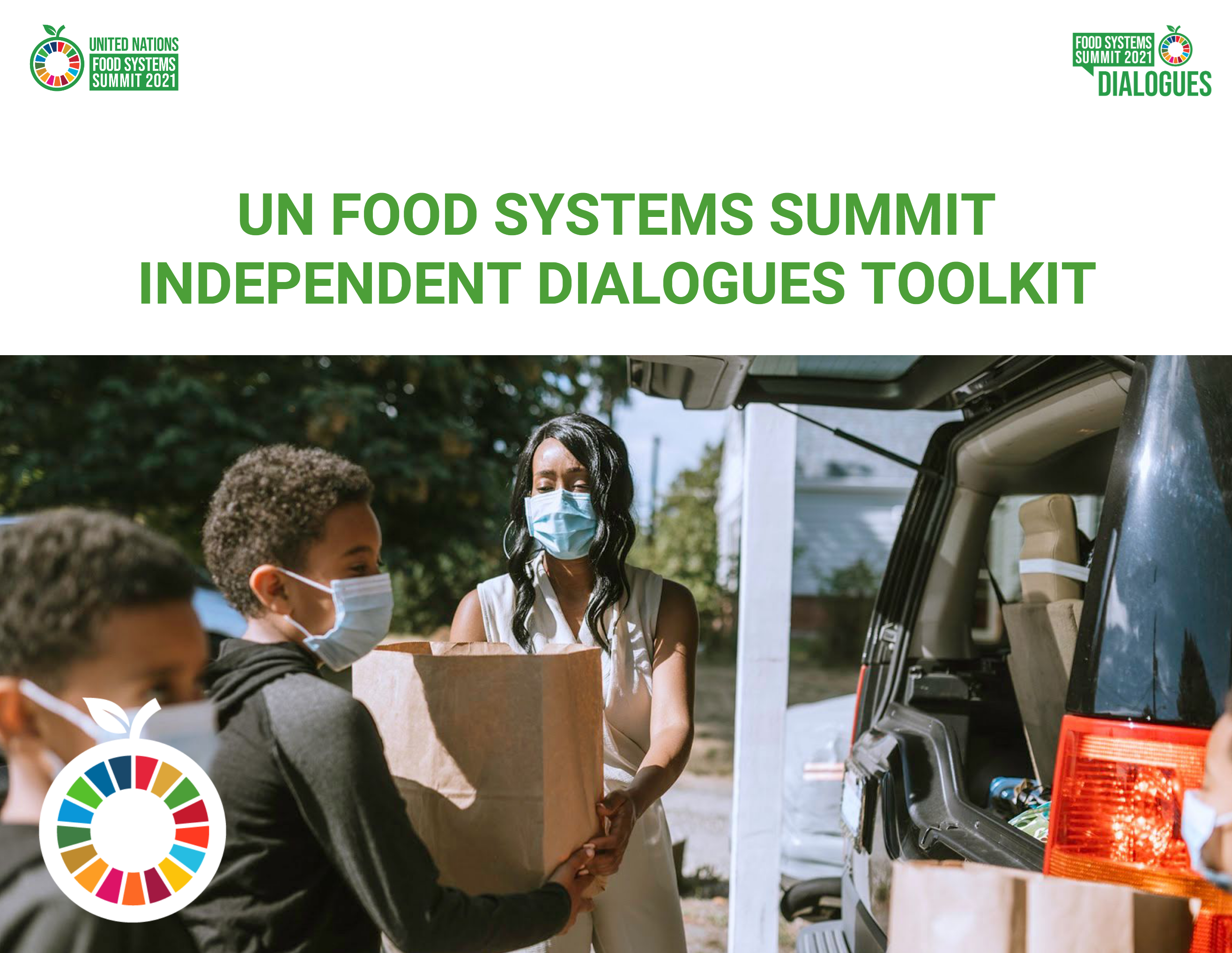Are you ready to begin your journey to convene a Food Systems Summit Dialogue?
This Step-by-Step Guide is the place to start.
Here, you will find a useful breakdown of the whole process—from deciding on a theme, to organizing your discussion groups, and submitting Official Feedback to the Summit. The communications material available will help you engage with your networks and explain the importance of convening a Dialogue.
As a Convenor we’ve outlined three essential actions that we think will ensure that your voice is heard, and that your Dialogue helps to shape the Summit:
- Commit to the principles and vision of the summit. You can find these on the Summit website. We also encourage you to share these with everyone who participates in your Dialogue.
- Announce your Dialogue. To do this, go to Your Dialogues and select “CREATE INDEPENDENT DIALOGUE.” Fill in all the relevant details, then click “ANNOUNCE NOW”. We also encourage you to use our toolkit to promote your Dialogue on your social networks.
- Submit your Official Feedback. After your Dialogue has taken place, you will be able to complete the Official Feedback Form, which you will see on Your Dialogues. Complete the form for the relevant Dialogue and click “PUBLISH NOW”. We encourage you to promote your Dialogue’s Official Feedback on the Food Systems Summit Community platform and reach members of the Summit’s Action Tracks, Scientific Group and Champions.
The information on this page is based on the Reference Manual for Convenors and the Handbook for Independent Dialogues. Download these resources and consider using the Convenor’s checklist (Excel) as a tool as you advance along the steps below. Click here to view a snapshot of what to expect of a typical Food Systems Summit Dialogue event using the standardized method.
Convenors of Independent Dialogues have a large degree of freedom in deciding the focus of the Dialogue and adapting the standard methodology. The only critical features of Independent Dialogues are that they must be aligned with the Food Systems Summit Principles of Engagement, be multi-stakeholder, and use the Official Feedback Form available on the Dialogues Gateway website.
If you have any questions, please contact the Food Systems Dialogues Team via the Helpdesk.
Start preparing for your Dialogue as early as possible!
PREPARE
- Register on the Dialogues Gateway – Success, you are here!
- Start the creation of an Independent Dialogue
- Access the Orientation and Training content to learn about the important role of the Convenor and tips along the way
- Define the focus and title of your Summit Dialogue (page 12 of the Reference Manual, page 10 of the Handbook, and click here to learn about Why Food Systems Matter and visit the UN Food Systems Summit website to find the latest information from the Action Tracks and independent Scientific Group).
- Invite your Dialogue Curator to your Independent Dialogue event page (under the “Manage Invitees” tab) and ask them to register on the Gateway to review materials and register for a Curator and Facilitator Training session as soon as possible.
Ideally 4 weeks beforehand.
ANNOUNCE
- The only information needed to announce your Dialogue event is a Dialogue event Title, Convenor information and the Date and Time. These details can be edited subsequently.
- Additional details can be added at a later stage including the name of your Curator, event format, city, a detailed description, acknowledgements and an image. You can also allow interested parties to contact you directly.
- You are encouraged to Announce your Dialogue on the Gateway as early as possible. By announcing your event on the Gateway, you publicize it on the Global Map of Dialogues and the details of your Dialogue will be visible for others.
Between 4 weeks to 2 days beforehand.
PLAN
- Create the agenda of your Dialogue event together with your supporters and Curator. Consider reviewing the Run of Show template (Excel). If you have special guests making high-level introductions and opening remarks they should be identified.
- Define and manage the invite list. Food Systems Summit Dialogues are built around the people that participate in them. Please consider diversity and especially the Food Systems Summit Principles of Engagement when devising your guest list (for more information, the Reference Manual). Once you have defined the list, go to the Dialogue event page and input the list in the “Manage invitees” tab – this is a useful way to track the invitations and gather profile information about your participants for the Official Feedback Form (after the Dialogue).
It is not necessary to manage invitees on the Gateway. If you use another tool to manage your invitations, please refer to the requirements of the Official Feedback Form so that you are able to gather the required information to appreciate diversity and inclusion: Age range, gender, Stakeholder Group and Sector.
- Send invitations.This designed invitation template is available for you to adapt to attach to emails for your Participants. If you are inviting your participants via group email, please protect the privacy of your participants by using the Blind Carbon Copy (bcc) field to ensure email addresses are not shared with the larger group. An invitation to a Food Systems Summit Dialogue is personal and should not be transferred, as uncontrolled transfer of invitations may upset the diversity of your Dialogue.
- Prepare any background materials and confirm Discussion Topics and Prompt Questions (see the Reference Manual for more information and examples). Once both the Discussion Topics and Prompt Questions are confirmed, insert them into the Facilitator Discussion Group Template for subsequent transmission to the Facilitators.
- Choose Facilitators and allocate them to Discussion Groups. You will need one Facilitator per Discussion Group, with each group accommodating 8 to 10 participants. Once identified, ask them to register on the Gateway to review available materials and to register for a Curator and Facilitator Training session. Share the Discussion Group templates with your Facilitators and ask whether they would find it helpful to have a rapporteur or notetaker. Note: It is helpful to have an additional Facilitator in reserve should you need to add an additional Discussion Group at the last minute.
- Set up and schedule. For online Dialogues ensure that your platform allows for breakout rooms. This Zoom online tutorial may be useful and ensure you have sufficient licenses for the number of hosts and technical support people you will need. For in-person Dialogues confirm the meeting room set-up with your chosen venue, also insuring there has been no change to COVID-19 regulations.
- Finalize your presentation (Optional). If you are using a presentation during your Dialogues event, this standard slide set is available for your use and adapt.
- Finalize the Run of Show and ‘event-day’ roles. To manage the technical execution of a Dialogues event, at least two people, in addition to the Curator and Facilitators, are required. If you are hosting an online Dialogue, they should be very familiar with the platform being used, including breakout room management. Everyone should have a reliable internet connection.
- Finalize Communications and Social Media. You are encouraged to communicate and promote your Dialogue on social media using the hashtag #SummitDialogues. If using twitter, tag the Summit account @foodsystems. Note: Information disclosed during the Dialogue may be reported by those present, but the source of that information may not be explicitly or implicitly identified. The intention with this is to encourage a safe space for sharing, but equally to create a space where ideas can be generated, and solutions can be identified. This can be referred to as “Chatham House Rules”. In some instances, like with have high-level speakers, you may want to consider allowing the opening speeches to be available to others, including the media and the rule would therefore not apply. View page 25 of the Reference Manual for more guidance on communications.
- Allocate Participants to Discussion Groups.It is recommended that there are no more than ten people at each discussion group, including the Facilitator and rapporteur or notetaker (if applicable). When allocating participants to Discussion Groups, it is important to consider once again the principle of multi-stakeholder inclusivity. Co-workers or people of similar disciplines and experience should be assigned to different groups. Once the assignment has been made no further participants should be added, but do be prepared to adjust this at the last minute. You may need to add or remove a Discussion Group depending on late registrations or people who are not able to join.
- Send a pre-event information email to Participants.Participants should be emailed 2 days prior to the event. The aim of this email is to solicit an update to their participation status and to share specific event related information such as a web conference link and password (for online events) and any pre-reading materials (if applicable).
- Final briefing with the Dialogues event team (Convenor, Curator, Facilitators, Dialogue Supporters – including technical team). The aim of this pre-event briefing is to gather the core team to review the Run of Show and key roles and responsibilities. It is a moment to address any outstanding questions. It may also be helpful to consider the types of questions participants are likely to ask and have standard responses ready. For online events this could include: Q: What is the login password? Q: Can I change Discussion Groups? Q: I cannot access my Discussion Group, what do I do? For in-person events ensure that all team members are familiar with local COVID-19 regulations, venue details, including emergency protocols and any related contingency measures.
Dialogue Day.
HOST
- Hold your event– Use the personalised Run of Show that you have developed. Consider and be prepared for unexpected issues, ensure your Curator, Facilitators and Participants are well supported.
- Facilitators, and/or notetakers should complete and return the Discussion Group templates as soon as possible, but no later than two days after the event.
- Good luck!
Within 2 weeks after the Dialogue.
PUBLISH FEEDBACK
- Prepare, complete and submit your Dialogue Feedback to the Food Systems Summit via the Official Feedback Form attached to your Dialogue event page as soon as possible, ideally within two weeks after your Dialogues event. Whilst others may support you in drafting the Official Feedback, as Convenor, you are responsible for submitting the final version. Once the Official Feedback has been submitted, it will be published online and accessible publicly.
- Stay connected with your participants and the Food Systems Summit. You are encouraged to stay connected with your participants, share the Official Feedback with them and indicate any next steps being decided.
- Celebrate your Food Systems Summit Dialogue. Communicate and celebrate the success of your Dialogue on social media, amongst your network and with the Food System Summit Action Tracks and independent group via the Community Platform.
Congratulations!
You have completed a Dialogue and contributed to the 2021 United Nations Food Systems Summit – you are playing an important role in bringing together different stakeholder groups to explore, debate and shape pathways to sustainable food systems that will contribute to all the Sustainable Development Goals.


